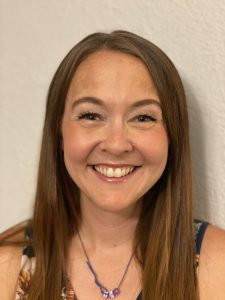Originally published in the Greater Park Hill News, March 31st, 2021
A Time To Move, Create, Connect, And Be Kind
By Erin Pier
For the GPHN

Last September in these pages, I compared the crisis of COVID-19 with that of Sept. 11, 2001. I shared my opinion that the pandemic, similar to 9/11, will be remembered for its division of history into “before and after.”
Back in September, the idea of life after COVID seemed so far out of reach, it was impossible to envision. But, as more and more Coloradans become eligible for the vaccine, hospitalizations decline and schools return to in-person, the post-pandemic world is slowly becoming a reality. With it, the consequences of this past year are beginning to make themselves known, though the lasting impacts may not be fully recognized for years to come.
Laughing while muted
As a school psychologist at a high school, it likely comes as no surprise that my biggest concern about COVID-19 fallout is the lasting impact on mental health for students and staff alike.
Humans are social creatures. We heal our grief, our pain, by the chemicals released in our brain when we connect with others. And yet, for the past year, we have been forced to distance ourselves from social connections. Families have lost loved ones to COVID-19, saying goodbye only through a computer screen. School communities have lost beloved members, unable to hug one another as they grieve. Relationships have ended. Pets have passed away.
We have experienced economic strain, fear of coughs in the supermarket, and the lack of meaningful connection. We’ve normalized Zoom calls, where everyone laughs at a joke while muted. We’ve second-guessed whether our comments in meetings are relevant or appreciated, without feedback to assure us. We have heightened anxieties and increased negative self-talk. We’ve been forced to normalize a condition that is very foreign to our species: isolation.
Research indicates that a lack of social connection is linked to numerous risks. Social isolation increases physical health risks similar to smoking 15 cigarettes a day or battling alcoholism. It also increases risks for cognitive impairment, lowered immunity, heart disease, and death. Psychologically, those who are socially isolated are more likely to develop disorders such as anxiety, obsessive-compulsive disorder, insomnia, depression and PTSD.
The Lancet, a medical journal, recently indicated that the impact of isolation, even less than 10 days, can lead to the presence of psychiatric symptoms for up to three years. Plain and simple: being alone causes harm to our bodies and our minds.
I don’t say this to stoke even more fear, rather, to acknowledge that as we enter this post-pandemic world, we do so with a whole host of very real consequences stemming from this past year of solitude, and no one is immune. We are dealing with a collective level of stress and social anxiety that is unparalleled in recent history, and our teachers, our students, our principals, our support staff and our parents have all been impacted.
As we return to our buildings, we must remember that learning what it’s like to be human again may be a raw and uncomfortable process — for all of us.
Coming to connect
As my high school students have begun to trickle into the building, it’s become evident that those who show up each day aren’t there for the academic support. They’re coming to connect. They want to see their principal or their favorite teacher, or their peers. They want to talk about everything that happened to them this year, all the things we couldn’t see behind their muted computer screen.
Schools must make space for these connections to happen, before we can begin to address any of the academic impacts of this year. I’ve mentioned Maslow’s Hierarchy of Needs in this column before, and it’s as true today as ever: we must attend to our most pressing needs before we can reach our highest potential, and certainly, before we can learn. Right now, the need for love, belonging, and connection, is the most pressing need.
The National Alliance on Mental Illness recommends strategies to cope with the stress brought about by the pandemic. Individuals and school communities can practice Dr. Sue Varma’s 4 Ms of Mental Health: movement (exercising), meaningful engagement (connecting with other people), mastery (being creative), and mindfulness (deep breathing and being aware).
Finding ways to incorporate these strategies into the school routine will help ease staff and students back into the post-pandemic world.
In the days and weeks that followed 9/11, many schools did not immediately jump right back into learning. Instead, they took time to unite in their grief, recovery and healing. The trauma of living through a pandemic has taken a much longer time to endure, but the effects and need to recover are very real. We must lead with grace and compassion. We must take time for children and staff to process everything that has transpired this past year.
We must make space to remember what makes us human.
Looking for a chance to heed one of Dr. Sue Varma’s recommendations, and meaningfully engage with your community? Join PHNEE’s monthly (virtual) EdEquity Corner on April 14 at 7 p.m. Register at this link: tinyurl.com/edequityapril21
Erin Pier is a mother of three, a Stedman parent and school psychologist at AUL Denver. She is an active member of the Park Hill Neighbors For Equity In Education, which works toward diversity, equity, and inclusion in all schools in the neighborhood.
